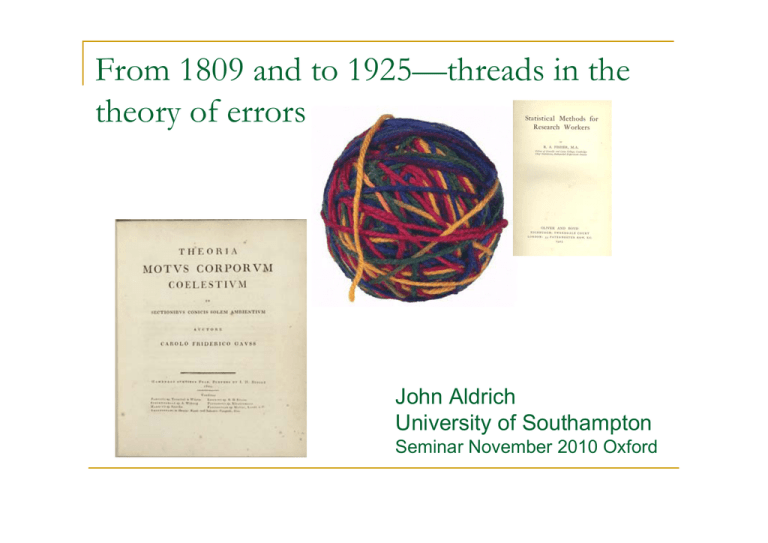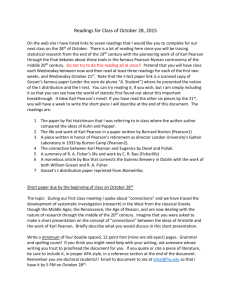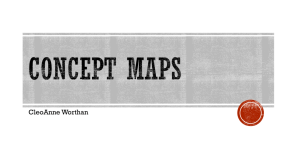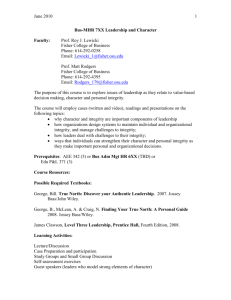From 1809 and to 1925—threads in the theory of errors John Aldrich
advertisement

From 1809 and to 1925—threads in the theory of errors John Aldrich University of Southampton Seminar November 2010 Oxford —Size In 1877 Merriman found 408 items—earliest in 1749 (Euler) 153 in German, 110 in French, 90 in English, 16 in Latin… 13 “proofs of the method of least squares” I follow 2 threads—one with 3 main characters, the other with 2 mains The talk draws on 2 papers: Lüroth, Dedekind and the Bayesian line in the theory of errors The theory of errors reborn as mathematical statistics—Fisher and Student 1908-25 but treats only one issue inference to the mean of the normal distribution—ultimately the t-distribution The threads Thread 1 begins in astronomy and is developed by mathematicians Thread 2 ends in one of a series of biological monographs and manuals mainly the work of a mathematician but it has come from laboratory work in a brewery. The threads are tenuously connected because thread 2 came from a corruption of thread 1… Thread I : C. F. Gauss (1777-1855) mathematician, astronomer, geodesist Theoria Motus (1809) introduces model for indirect observations Precision parametrised by Uniform prior for β → max prob value given by least squares Precision of βs given relative to h But no inference on h. W. F. Bessel (1784-1846) astronomer, geodesist Introduced the probable error mean ± probable error gives a 50% interval for a normally distributed quantity Bessel’s estimate of p.e. based on mean error (direct observations) Gauss 1816 …. …. Estimates h. No mean or regression parameters Maximum posterior value of h assuming implicitly a uniform prior. 50% limits for h (normal approximation) Then a change of direction Large sample properties of alternative estimators of h. Mean square estimator most efficient (Fisher-speak) Second proof of least squares—Gauss 1822-3 New frequentist approach to least squares based on "Gauss-Markov theorem." This was not widely taught in the nineteenth century. An innovation that did take root involved the estimation of precision: instead of sample size use the number of degrees of freedom (Fisher-speak). Gauss taught least squares—both proofs—most years until his death in 1855 Students —astronomers including Schumacher (1780-1850) who founded Astronomische Nachrichten Encke—see below —mathematicians including Dedekind (1831-1917)— see below. Richard Dedekind, student 1850 … or t(m-n+1) 1860 paper has regression and precision parameters. maximises marginal posterior. focuses on precision. Confirms that least squares gives the most prob value of marginal posterior—for which he needs that marginal. J. F. Encke (1791-1865) Gauss student 181113, astronomer, populariser and combiner Gauss and Bessel “combine the strictest theory with the happiest practical applications of theoretical truths.” Gauss (1809): maximum probability estimate Gauss (1823): estimate of precision Bessel: probable error Dedekind followed up: Jacob Lüroth (1844-1910) geometer with an interest in astronomy …. Compares probable error formula based on Dedekind distribution (R1) with the usual (Encke) formula (r1): p degrees of freedom No big deal End of thread I Merriman comments on Lüroth Lüroth disappears until Pfanzagl and Sheynin (1996)--“ A Forerunner of the t-Distribution” Similar analyses from Edgeworth (1883), Burnside (1923) and Jeffreys (1931) Perhaps elsewhere too? A new thread … Student (Gosset) & Fisher Early C20 Britain a sleepy time in error theory A lively time in biometry Leading biometrician Karl Pearson was not much interested in error theory But he got entangled Student sought Pearson’s help on an error theory problem Later Fisher applied error theory ideas to Pearson’s projects William Sealy Gosset chemist and brewer E. S. Pearson: “All this is simply Airy or Merriman put by Gosset into the form most useful for his fellow brewers.” A bit more ingenious but no real innovations Airy or Merriman … Merriman descended from Encke via Chauvenet: the Bayesian element attenuated. Airy not at all Bayesian—but not very informative about practice 1905 Gosset consults Karl Pearson, biometrician Pearson wasn’t interested in error theory but had lots of ideas Bayesian arguments significance testing fitting by method of moments large sample theory correlation 1908 two half baked studies? Obtains sampling distribution Uses it as a posterior distribution hint here of analysis with uninformative prior? incomplete too? Obviously incomplete Fails to obtain sampling distribution for correlation— except for null case Bayesian scheme of combining sampling distribution with prior cannot be realised The mean paper’s distributions: s and z … Proceeding in the spirit of Pearsonian curve fitting but calculating theoretical moments … Following Pearson, the estimate s divides by the sample size. Following nobody, the z ratio divides by s and not by s/√n. 1912 A half baked paper on estimation … Fisher proposed the de-Bayesed method of Merriman as a universal criterion—the future maximum likelihood. Its virtue—absoluteness = invariance. The Bayesian approach was rejected Common ground with Student? Evidently not—BUT the absolute criterion existed in 2 versions 2nd version: to estimate h use the density of μ2 (sample variance). Fisher had an estimation interest in the density of the sample variance—and derived it. When he came into contact with Gosset he used the same method to work out the density of z. 1915: Fisher on correlation …. …. Fisher’s derivation of Student’s z was not published But Pearson published a later piece on the correlation coefficient Pearson thought this is important Gosset “there still remains the determination of the probability curve giving the probability of the real value” 1920 Fisher tells the astronomers But new idea of sufficiency Arthur Eddington claims that the mean error estimate is superior to the mean square estimate. Fisher says no, producing results first obtained by Gauss in 1816 and Helmert in 1876 1922 Regression moves … we are in a Regression lived in the multinormal Gosset asked Fisher for the distribution of a regression coefficient looking for a follow-up to the correlation results of 1915 He got a follow-up to Student on the mean As error theory natural –from direct to indirect observations 1922 z turns into t … … The present tables, have, therefore, at Mr Fisher’s suggestion been constructed with argument t =z√n, where n is now one less than the number in the sample. Student 1925 In 1922 Gosset decides to produce new tables of z Fisher has a new method of computing the values And there are two parallel projects By November 1922 they are using the t form New tables appear in 1925/6 Bayesian diversion 1923 Proceedings of the Cambridge Philosophical Society Burnside “On Errors of Observation” Fisher “Note on Dr. Burnside's Recent Paper on Errors of Observation” Gosset to Fisher It is interesting to see how à priori probability has got him just off the line. … it is a good instance of the futility of á priori assumptions Yet Gosset’s position re Bayes remains unclear. In retirement the group theorist William Burnside takes up error theory Produces a Bayesian analysis of Student’s problem Fisher writes indicating Student’s priority Gosset underwhelmed by Burnside A system of distributions 1924 … A new z Convergence of different streams of research Some work coming out of Pearsonian statistics Some work coming out of a rejuvenated theory of errors 1925: t arrives Statistical Methods for Research Workers "Applications of `Student's' distribution" and two articles about tables "Expansion of `Student's' integral in powers of n⁻¹“ Student's "New tables for testing the significance of observations." Beginnings and ends Dedekind and Lüroth Contributions look like something Gauss could have written in 1816 All the ideas were available then Dedekind—like Gauss focussed on precision Dedekind and Lüroth did not impose their constructions Student and Fisher inherited a very thin version of the theory of errors had a productive interaction with biometry with Student a lot of confusion with Fisher a new subject






